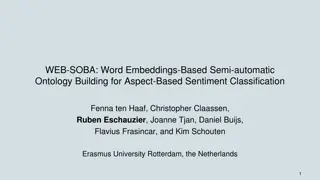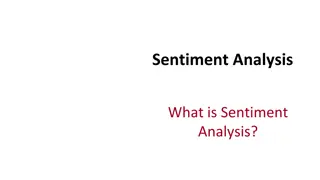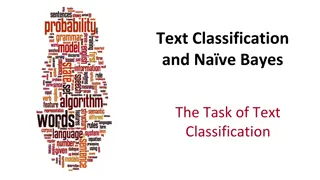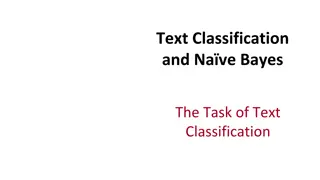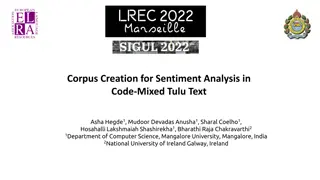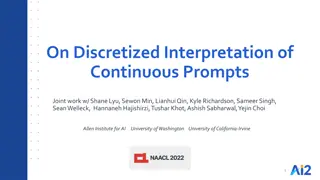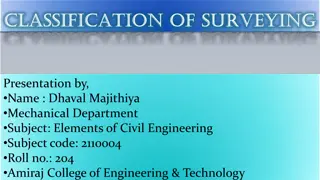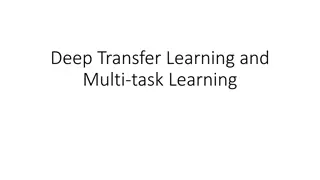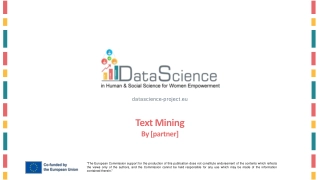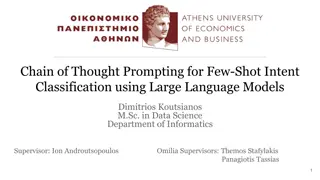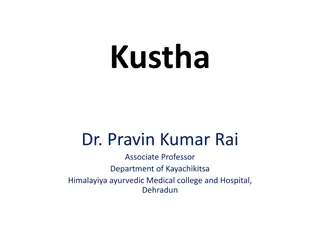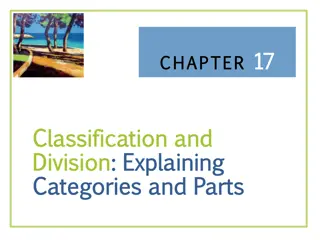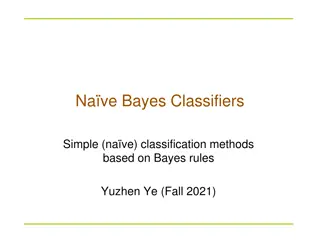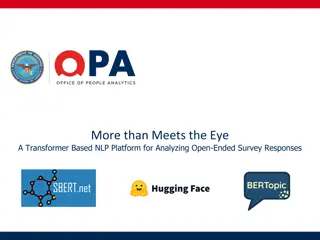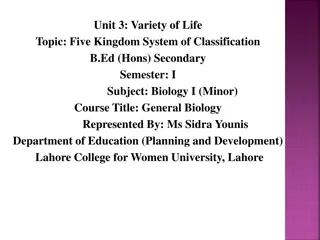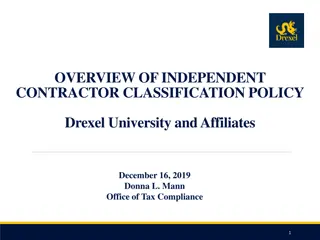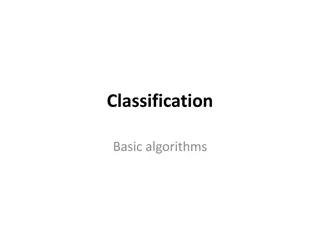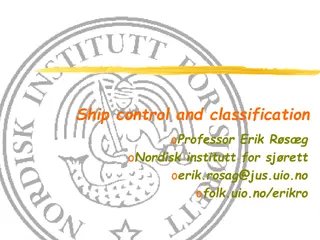Understanding Sentiment Classification Methods
Sentiment classification can be done through supervised or unsupervised methods. Unsupervised methods utilize lexical resources and heuristics, while supervised methods rely on labeled examples for training. VADER is a popular tool for sentiment analysis using curated lexicons and rules. The classification pipeline involves tokenization, feature extraction, selection, weighting, and learning. Skikit-learn provides a range of algorithms for data processing and machine learning. Deep learning is also used for sentiment analysis.
Download Presentation

Please find below an Image/Link to download the presentation.
The content on the website is provided AS IS for your information and personal use only. It may not be sold, licensed, or shared on other websites without obtaining consent from the author. Download presentation by click this link. If you encounter any issues during the download, it is possible that the publisher has removed the file from their server.
E N D
Presentation Transcript
Unsupervised Sentiment Classification Unsupervised methods do not require labeled examples. Knowledge about the task is usually added by using lexical resources and hard-coded heuristics, e.g.: Lexicons + patterns: VADER Patterns + Simple language model: SO-PMI Neural language models have been found that they learn to recognize sentiment with no explicit knowledge about the task.
Supervised/unsupervised Supervised learning methods are the most commonly used one, yet also some unsupervised methods have been successfully. Unsupervised methods rely on the shared and recurrent characteristics of the sentiment dimension across topics to perform classification by means of hand-made heuristics and simple language models. Supervised methods rely on a training set of labeled examples that describe the correct classification label to be assigned to a number of documents. A learning algorithm then exploits the examples to model a general classification function.
VADER VADER (Valence Aware Dictionary for sEntiment Reasoning)uses a curated lexicon derived from well known sentiment lexicons that assigns a positivity/negativity score to 7k+ words/emoticons. It also uses a number of hand-written pattern matching rules (e.g., negation, intensifiers) to modify the contribution of the original word scores to the overall sentiment of text. Hutto and Gilbert. VADER: A Parsimonious Rule-based Model for Sentiment Analysis of Social Media Text. ICWSM 2014. VADER is integrated into NLTK
The classification pipeline The elements of a classification pipeline are: 1. Tokenization 2. Feature extraction 3. Feature selection 4. Weighting 5. Learning Steps from 1 to 4 define the feature space and how text is converted into vectors. Step 5 creates the classification model.
Skikit-learn The scikit-learn library defines a rich number of data processing and machine learning algorithms. Most modules in scikit implement a 'fit-transform' interface: fit method learns the parameter of the module from input data transform method apply the method implemented by the module to the data fit_transform does both actions in sequence, and is useful to connect modules in a pipeline.
Convolutional Neural Network A convolutional layer in a NN is composed by a set of filters. A filter combines a "local" selection of input values into an output value. All filters are "sweeped" across all input. A filter using a window length of 5 is applied to all the sequences of 5 words in a text. 3 filters using a window of 5 applied to a text of 10 words produce 18 output values. Why? Filters have additional parameters that define their behavior at the start/end of documents (padding), the size of the sweep step (stride), the eventual presence of holes in the filter window (dilation). During training each filter specializes into recognizing some kind of relevant combination of features. CNNs work well on stationary feats, i.e., those independent from position.
CNN for Sentiment Classification S Not going to the beach tomorrow :-( Multilayer perceptron with dropout embeddings for each word convolutional layer with multiple filters max over time pooling Embeddings Layer, Rd(d = 300) Convolutional Layer with Relu activation Multiple filters of sliding windows of various sizes h ci = f(F Si:i+h 1 + b) max-pooling layer dropout layer linear layer with tanh activation softmax layer 1. 2. 3. Frobenius matrix product 4. 5. 6.
Sense Specific Word Embeddings Sentiment Specific Word Embeddings LM likelihood + Polarity U the cat sits on Uses an annotated corpus with polarities (e.g. tweets) SS Word Embeddings achieve SotA accuracy on tweet sentiment classification
Learning Generic loss function LCW(x, xc) = max(0, 1 f (x) + f (xc)) SS loss function LSS(x, xc) = max(0, 1 ds(x) f (x)1 + ds(x) f (xc)1) Gradients 1 1 ? ?? ??(?,??) > 0 ???(?) ? ???(??) = 0 0 ?? ?????? 0
Semeval 2015 Sentiment on Tweets Team Phrase Level Polarity Tweet Attardi (unofficial) Moschitti KLUEless IOA WarwickDCS Webis 67.28 64.59 61.20 62.62 57.62 64.84 84.79 84.51 82.76 82.46
SwissCheese at SemEval 2016 three-phase procedure: 1. creation of word embeddings for initialization of the first layer. Word2vec on an unlabelled corpus of 200M tweets. 2. distant supervised phase, where the network weights and word embeddings are trained to capture aspects related to sentiment. Emoticons used to infer the polarity of a balanced set of 90M tweets. 3. supervised phase, where the network is trained on the provided supervised training data.
Ensemble of Classifiers Ensemble of classifiers combining the outputs of two 2-layer CNNs having similar architectures but differing in the choice of certain parameters (such as the number of convolutional filters). networks were also initialized using different word embeddings and used slightly different training data for the distant supervised phase. A total of 7 outputs were combined
Results 2013 2014 2015 2016 Tweet Sarcas m Live- Journal Tweet SMS Tweet Tweet Avg F1 Acc SwissCheese Combination 64.61 70.05 63.72 71.62 56.61 69.57 67.11 63.31 SwissCheese single 67.00 69.12 62.00 71.32 61.01 57.19 59.218 58.511 62.718 38.125 65.412 58.619 57.118 63.93 UniPI 64.2 60.6 68.4 48.1 66.8 63.5 59.2 UniPI SWE 65.2
Breakdown over all test sets SwissCheese Prec. Rec. F1 UniPI 3 Prec. Rec. F1 67.48 74.14 70.88 65.35 68.00 positive 70.66 positive 53.26 67.86 50.29 58.93 54.27 negative 59.68 negative 71.47 59.51 64.94 68.02 68.12 neutral neutral 68.07 61.14 Avg F1 65.17 Avg F1 64.62 Accuracy Accuracy 65.64
Sentiment Classification from a single neuron A char-level LSTM with 4096 units has been trained on 82 millions of reviews from Amazon. The model is trained only to predict the next character in the text After training one of the units had a very high correlation with sentiment, resulting in state-of-the-art accuracy when used as a classifier. The model can be used to generate text. By setting the value of the sentiment unit, one can control the sentiment of the resulting text. Blog post - Radford et al. Learning to Generate Reviews and Discovering Sentiment. Arxiv 1704.01444


